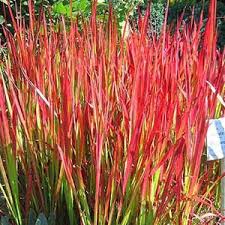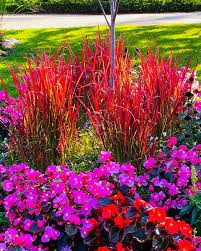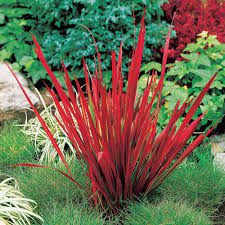Blood Grass, scientifically known as Imperata cylindrica, is a type of grass that is known for its beautiful appearance and unique characteristics. This grass is also sometimes referred to as “Cogon Grass” or “Japanese Blood Grass.” It can be easily identified by its vibrant red and green leaves, which resemble the colors of blood and give the plant its intriguing name.
The Blood Grass is a hardy and adaptable plant that can thrive in a variety of environments. It is commonly found in grasslands, open areas, and along roadsides. This grass has a spreading growth habit and can form dense clumps, which makes it effective for erosion control on slopes.
One of the most distinctive features of Blood Grass is its color-changing leaves. During the warmer months, the leaves develop a deep red hue that intensifies as the season progresses. This reddish coloration is attributed to the presence of pigments called anthocyanins. These pigments protect the plant from excessive sunlight and help it conserve water, making Blood Grass well-suited to hot and arid conditions.
Blood Grass is a perennial plant, meaning it lives for several years, and it spreads through its rhizomes—underground stems that produce new shoots. While its unique appearance makes it a popular choice for ornamental purposes in gardens and landscapes, it’s important to note that Blood Grass can become invasive in some regions. Its rapid growth and ability to outcompete native plants can disrupt ecosystems.
Gardening enthusiasts often appreciate Blood Grass for its ability to add a dramatic touch to their landscapes. Its red foliage can serve as a focal point or an accent in gardens. When paired with other plants, it creates a visually appealing contrast that captures attention.
In terms of care, Blood Grass is relatively low-maintenance. It prefers full sun but can tolerate partial shade as well. Well-draining soil is essential to prevent waterlogged roots. Regular watering is necessary during the establishment phase, but mature Blood Grass is quite drought-tolerant. Pruning is recommended to manage its growth and maintain its attractive appearance.
In addition, Blood Grass (Imperata cylindrica) is a captivating grass known for its striking red and green leaves. It adapts well to different environments, making it a versatile choice for landscaping. Its ability to change color adds to its appeal, though its invasive potential should be considered. Whether as an ornamental addition to a garden or a functional erosion controller, Blood Grass continues to be a fascinating and visually arresting plant.
Read Also: 10 Medicinal Health Benefits of Wrightia demartiniana (Pala Indigo Plant)
How to Grow and Care for Blood Grass

Growing and caring for Blood Grass (Imperata cylindrica) can be a rewarding experience. Here are some simple steps to help you successfully cultivate and maintain this beautiful grass:
1. Location: Choose a spot that receives full sun to partial shade. Blood Grass prefers sunlight but can tolerate some shade. Ensure that the area has well-draining soil to prevent waterlogged roots.
2. Soil Preparation: Prepare the soil by loosening it to a depth of about 6-8 inches. You can also mix in organic matter like compost to improve soil structure and drainage.
3. Planting: You can plant Blood Grass using seeds, plugs, or divisions. If using seeds, sow them in the prepared soil and lightly cover with a thin layer of soil. Water gently. If using plugs or divisions, plant them at the same depth they were growing previously. Space plants about 1 to 2 feet apart to allow for their spreading growth.
4. Watering: Water the newly planted Blood Grass regularly during the first few weeks to help it establish its roots. Once established, the grass is relatively drought-tolerant and does not require frequent watering. Water when the soil feels dry to the touch, but avoid overwatering.
5. Mulching: Applying a layer of mulch around the base of the plants can help retain moisture, suppress weeds, and regulate soil temperature.
6. Pruning: To keep Blood Grass looking tidy and to prevent it from becoming invasive, trim back any dead or damaged leaves and flower spikes. You can do this in late winter or early spring before new growth begins.
7. Fertilizing: Blood Grass doesn’t require heavy fertilization. You can apply a balanced, slow-release fertilizer in the spring to promote healthy growth. Follow the manufacturer’s recommendations for application rates.
8. Controlling Invasiveness: Keep an eye on the grass’s growth, as it can spread aggressively. To prevent it from becoming invasive, consider planting it in containers or using barriers to restrict its spread.
9. Winter Care: Blood Grass is hardy in most climates but may benefit from a layer of mulch around the base in colder regions to protect the roots from freezing temperatures.
10. Monitoring: Regularly inspect the plant for any signs of pests or diseases. If you notice any issues, take appropriate measures to address them promptly.
Remember that while Blood Grass is visually appealing, it can be invasive in certain areas. Before planting, check with your local extension office or gardening experts to determine if it’s a suitable choice for your region.
By following these simple steps and providing the right conditions, you can enjoy the beauty of Blood Grass in your garden while ensuring its health and vitality.
Benefits and Uses of Blood Grass

Blood Grass (Imperata cylindrica) offers several benefits and has various uses, making it a versatile plant in different contexts or ways:
1. Erosion Control: Blood Grass is often used for erosion control due to its spreading growth habit and strong root system. It can help stabilize soil on slopes, preventing erosion caused by rainfall and water runoff.
2. Ornamental Landscaping: The striking red and green foliage of Blood Grass makes it a popular choice for ornamental landscaping. It adds a vibrant and dramatic touch to gardens, borders, and landscapes, creating visual interest and contrast.
3. Focal Point: Blood Grass can serve as a focal point in garden designs due to its unique coloration. Planted strategically, it can draw attention and become a centerpiece in the landscape.
4. Accent Plant: In addition to being a focal point, Blood Grass can be used as an accent plant to provide a splash of color and texture among other plants. Its distinct appearance helps create captivating visual compositions.
5. Container Planting: Blood Grass can be grown in containers, adding a touch of nature to patios, decks, and balconies. Just ensure that the container has good drainage to prevent waterlogging.
6. Traditional Medicine: In some cultures, Blood Grass has been used for its potential medicinal properties. It has been believed to possess properties that may help with issues like fever, inflammation, and digestive discomfort. However, it’s important to note that scientific research supporting these claims is limited.
7. Livestock Forage: In some regions, Blood Grass has been used as fodder for livestock, particularly in areas where other forage options are scarce. It can provide sustenance to animals during dry periods.
8. Craft and Floral Arrangements: The distinctive red leaves of Blood Grass can be used in craft projects and floral arrangements to add color and texture. They can be dried and preserved for use in various creative endeavors.
9. Educational Purposes: Blood Grass can be used for educational purposes to teach about plant growth, ecology, and invasive species. Its rapid spread can serve as a lesson in the potential impacts of introducing non-native plants to new areas.
10. Natural Landscapes: Blood Grass can be integrated into natural landscapes and prairie restorations to contribute to biodiversity and provide habitat for wildlife.
11. Biofuel Potential: Some research suggests that Imperata cylindrica could have potential as a biofuel feedstock due to its high biomass production. However, further study is needed to determine its feasibility and sustainability.
While Blood Grass offers various benefits and uses, it’s important to be cautious about its potential invasiveness in some regions. Before introducing it to your garden or landscape, it’s advisable to research local regulations and consult gardening experts to ensure that it won’t negatively impact native plant species and ecosystems.
Read Also: 11 Medicinal Health Benefits of Davallia Divaricata (Rabbits Foot Fern)
Where to Find Blood Grass near Me/You

Here are three perfect places to find or locate Blood Grass (Imperata cylindrica) near you:
1. Garden Centers and Nurseries: Most garden centers and nurseries carry a variety of ornamental plants, including Blood Grass. Visit your local garden centers during the planting season to see if they have Blood Grass available. Nursery staff can also provide valuable information on planting and caring for the grass.
2. Online Plant Retailers: Many online plant retailers offer a wide range of plants, including Blood Grass. You can browse through different options, read reviews, and choose the best source that suits your needs. Make sure to order from reputable and established online retailers to ensure the quality of the plants.
3. Botanical Gardens and Arboretums: Botanical gardens and arboretums often feature diverse plant collections, and they might have Blood Grass on display. Visiting these locations not only allows you to see the plant in person but also provides an opportunity to learn more about its growth habits and care requirements.
Remember to consider your local climate and conditions when selecting a source for Blood Grass. Additionally, before planting Blood Grass, be aware of its potential invasiveness in your region and take necessary precautions to prevent it from spreading uncontrollably.
Read Also: Exploring the Benefits of Computer Technology Skills
